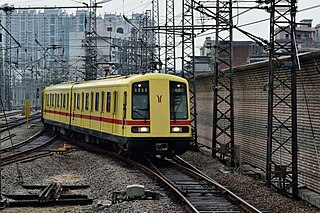Related Research Articles

Japan Standard Time, or Japan Central Standard Time, is the standard time zone in Japan, 9 hours ahead of UTC (UTC+09:00). Japan does not observe daylight saving time, though its introduction has been debated on several occasions. During World War II, the time zone was often referred to as Tokyo Standard Time.

Shaoshan is a county-level city in Hunan Province, China. It is under the administration of the prefecture-level city of Xiangtan. Qingxi Town is its seat.

Buan County (Buan-gun) is a county in North Jeolla Province, South Korea. It is bounded by the city of Jeongeup on the east, the county of Gochang on the south, the city of Gimje on the north, and Yellow Sea on the west. Buan is divided into 1 eup, 12 myeon, and 510 ri. Buan had a 2001 estimated population of 74,716 people and a 2018 population of 54,441 people with an area of 493.35 km2. Famous people from Buan include Joseon Dynasty kisaeng and poet, Yi Mae-chang. Like many rural areas in southern Korea, it has seen shrinking population with many younger people moving north to larger cities such as Seoul. This county should not be confused with Muan, the new capital of South Jeolla Province.

Changnyeong County is a county in South Gyeongsang Province, South Korea.

The Ministry of Defense is an executive department of the Government of Japan responsible for preserving the peace and independence of Japan, and maintaining the country’s national security and the Japan Self-Defense Forces.

The 7.7×58mmArisaka cartridge was the standard military cartridge for the Imperial Japanese Army's and the Imperial Japanese Army Air Service during World War II. The 7.7×58mm cartridge was designed as the successor of the 6.5×50mmSR cartridge for rifles and machine guns but was never able to fully replace it by the end of the war.

Sōshi-kaimei was a policy of pressuring Koreans under Japanese rule to adopt Japanese names and identify as such. While the process was nominally voluntary, those who did not change their names were severely disadvantaged in society.

Line 1 of the Guangzhou Metro runs from Xilang to Guangzhou East Railway Station. Apart from Kengkou and Xilang, all stations in Line 1 are underground. The first section, from Xilang to Huangsha, opened on 28 June 1997, making Guangzhou the fourth city in mainland China to have a metro system. Construction took a total of 66 months. The total investment is 12.2616 billion yuan with an average cost per kilometer of 662.9 million yuan. The full line started operation on 28 June 1999. Line 1 is coloured yellow.

A Gokoku Shrine is a shrine dedicated to the spirit of those who died for the nation. They were renamed from Shōkonsha (招魂社) in 1939. Before World War II, they were under the jurisdiction of the Ministry of the Interior, but after World War II they are administered by an independent religious corporation. Designated Gokoku Shrines were built in prefectures except Tokyo and Kanagawa Prefecture. The main deities are war dead from the prefecture or those who are related to them, as well as self-defense officers, police officers, firefighters, and others killed in the line of duty.
China Railway Nanning Group, officially abbreviated as CR Nanning or CR-Nanning, formerly, Nanning Railway Administration is a subsidiaries company under the jurisdiction of the China Railway. The railway administration was reorganized as a company in November 2017.

Ruanjiandadao station, is a station of Line 1 of the Nanjing Metro, named after and located along the eponymous avenue of the same name. It began operations on 28 May 2010, as part of the southern extension of line 1 from Andemen to CPU.
A miscellaneous school is a classification of schools under the education laws of Japan and South Korea.
Cao Ju was an imperial prince of the state of Cao Wei in the Three Kingdoms period of China.
Litian is a town of Liling City in Hunan Province, China. It is surrounded by Jingang Town on the north, Shangli County on the east, Guanzhuang Town on the west, and Baitutan Town on the south.

House of Councillors elections were held in Japan on 21 July 2019 to elect 124 of the 245 members of the House of Councillors, the upper house of the then 710-member bicameral National Diet, for a term of six years.
Cheorwon County was a historical county of Korea.
Kumsong County was a historical county of Korea. It was established in 1018, and merged into Kimhwa County in 1914. In July 1953, after Korean War, most of Kumsong County merged into Kimhwa County of North Korea/
References
- ↑ 칙령 제98호 地方制度改正件 (1895년 음력 5월 26일)
- ↑ 칙령 제36호 地方制度官制改正件 (1896년 8월 4일)
- ↑ 조선총독부령 제111호 (1913년 12월 29일)